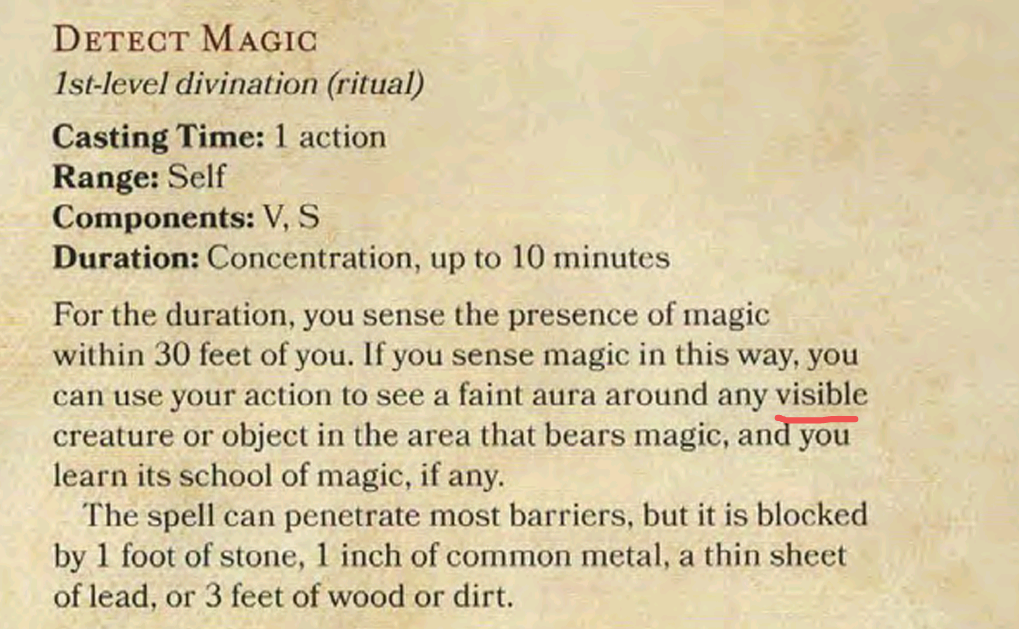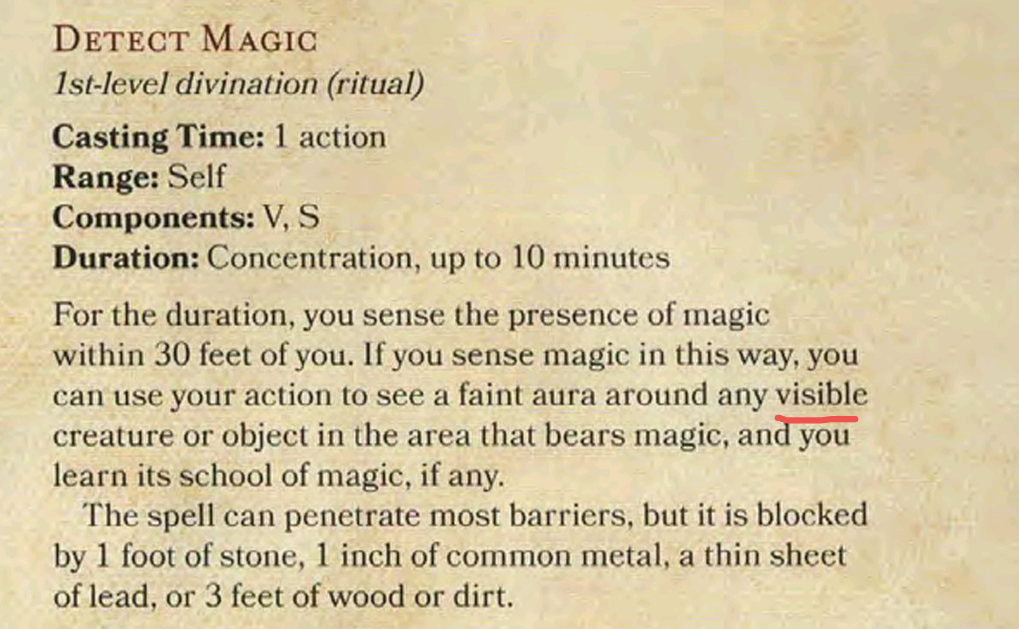I suppose you could cast see invisibility or true seeing first? But… yeah if I’m GMing you can just target the invisible wall, fuck that. Same goes for how RAW it’s nearly impossible to destroy the red layer of a prismatic wall because every spell that deals cold damage explicitly only targets creatures
Oh definitely. I assume that RAI this is the intention.
In a pedantic thread re: RAW, you misspell “definitely”. More than once. 🤌🏼
Oh gosh that’s wild. Whoops.
I thought it was funny, to be fair 🤣
I actually think it’s funny too.
Yeah I thought of that one as well. It’s one of those weird cases of imprecise wording.
To be pedantic, the issue is actually caused by precise wording. The wording is so precise it limits it too much. The wording is too precise, and inaccurate.
To be very pendantic, it’s the other way around: The wording as very precise at describing both spells, but quite vague at describing their interaction. That’s what leads to the problem.
I would say that’s a lack of accuracy, not precision. If it was less precise than it’s work on more things, and be less focused on one particular thing. If it’s more accurate than it is better at describing all targets.
Precision: Is your grouping tight.
Accuracy: Are you aiming at the target.
Precision without accuracy is you very narrowly describe what it does, but you miss the desired target (the player being able to use the spell in a reasonable way).
Fair.
Tired of pesky adventurers always seeing your tricks? Try applying Invisible metamagic to conjured Fog today!
If you can target an invisible wall, it introduces a lot of ways for things to go wrong. The spell caster is taking elements on faith and making assumptions, and those can be subverted…
I’d argue you can ‘see’ the wall if you place something on it, like:
- your hand
- your frontline’s hand (or some other body part)
- a ghost’s hand
- flour, dust, tar, enemies’ blood, coughing syrup, and other things that could stick to the surface
- gecko, spider, and other creatures that wouldn’t fall off; probably also your familiar; dhampir and a high level monk should work, too
By that logic you can see air because there’s clouds in the sky.
Son of a bitch, that’s a good argument.
There’s also blue in the sky. That’s literally you seeing the air
Actually that’s us seeing light.
Edit: specifically, the light wavelength that remains at passing through the atmosphere. We’re but seeing the air still, we’re just seeing the color that makes it through to us. Saying that’s the air itself would be like saying you see the cities filtration system by looking at the clean water that comes from a faucet.
A better example of actually seeing air would be to freeze it, and seeing the literal frozen air.
Light bouncing off of air molecules, yes. That’s how seeing things works
Do you see your own eyes? Like without a mirror
No. Why is that relevant?
I was extremely baked when I asked that but I think it was a question about how some light will reflect off your eye into your eye therefore you’re seeing your own eyes.
That’s what seeing is. Light. You can’t actually directly observe the atoms that make something up. You can see the light that is reflected/emitted from that object.
everything you see is light
Responding to your edit:
You’ve got it the wrong way around. What you see at sunset, the reds and yellows, that’s the sunlight being filtered because those wavelengths make it through stronger. Your argument would hold there, if we do not count seeing filtered light as “seeing” the filtering material. (Although even that I’d question - if you hold a colored piece of glass against a light source so it’s entirely backlit, would you say you’re not seeing it?)
But the blue sky is not that. It is the air molecules being illuminated by light coming from somewhere else, and bouncing that light back into your eyes, with a bias towards blue wavelengths. If that does not count as “seeing” air, then you also can’t actually “see” fog, it’s the same mechanism.
How about blind or very sight-impaired characters? Could they “see” the wall as they “see” everything, by touching/perceiving it? That’s as well as they can see anything.
Is seeing the same as visualizing? Because the cloud’s shapes and height clearly give you an idea where a mass of air with certain common characteristics is, where it starts, and where it ends.
It would be kind of neat that you would have to learn to see what can’t be seen to destroy something like force wall, because that would mean the blind would actually be better casters.
Or just interpret it as line of sight.
I’d argue that RAW the wall is still invisible. You now just have the means to pinpoint it’s location.
- Detect magic.
Nope

Technically it only refers to visible creatures. Objects doesnt have the adjective visible.
Unlikely, but a particularly bull headed person could read this as though detect magic could identify invisible objects.
I’m kinda surprised how vague many of the DnD rules are written.
Didn’t they have a rules lawyer at hand when writing these?
That depends on interpretation of the sentence structure. It could mean “any visible [creatures and objects]” or “any [visible creatures] and objects”.
I’ve specifically focused on means that don’t require a spell slot to use. Left familiar as an exception because people like to have them anyway and it can be ritual cast.
So you need Detect Magic running?
Or a bag of flour to throw around to make the wall visible
Just Last Crusade it and throw some dirt on the wall.
It’s technically still invisible. But as there is no clear rule for that I’d say it’s up to interpretation.
Nope

Oh dear I didn’t even know that. Well that makes it even more absurd.
Ope great catch
Entirely unrelated, but I love how this makes it seem like magical items emit radiation that gets blocked by objects and gets detected by the geiger counter spell that is detect magic.
Yes. See invisibility should work as well. Both are quite annoying to activate when in a fight though.
Edit: TIL that detect magic may not work, because the object has to be visible.
Definitely. If one is trying to be prepared, See Invisibility lasts an hour but takes a lvl 2 slot while Detect Magic lasts 10 minutes and only takes a lvl 1 slot, so there’s tradeoffs for sure.
One of the things I like about my firbolg twilight cleric is having the detect magic racial ability, too.
I would go line of fire logic.
You theoretically can not target the wall, but you can target something on the outerside and will then hit the wall instead
As I have said in another comment, that is RAW not what would happen:
“You can’t even cast it on something behind the wall, because you cannot target something (or someone) with a spell if they are behind total cover. Total cover is created by being behind completely behind an obstacle (like a wall). This counts even if the obstacle is invisible.”
Furthermore, because if you chose an invalid target for a spell, you’d still expend the spellslot but there would be no effect. So you actually spend a sixth level spell a lot to achieve nothing."
It’s very much not RAI I’d say and I would likely handle exactly like you described, but the RAW was so wonky that I wanted to make the meme when I found out about it.
“Specific overrides general” is RAW though, and the spell description of Wall of Force calls out that exact spell interaction as a way to destroy it.
The wording simply says “a disintegrate spell”. It does not say what it has to be cast on or wether it continues to travel towards the real target afterwards. But the implication clearly is that you have to hit the wall. Thus, RAW, even with specific overriding general, you cannot target the wall because it is invisible (nothing in its spell description states otherwise) and you can’t target space behind the wall, as it is behind cover.
Perception check
In order for the specific circumstance called out by the disintegrate spell description to be possible it requires a violation of the general case, yes. That is literally the point of the “specific overrides general” rule.
One of two things must be true for disintegrate to be able to destroy a wall of force:
1: The Wall is targetable by disintegrate.
2: Objects on the far side of the wall are targetable by disintegrate and the wall gets in the way.
For “specific overrides general” to hold a DM must rule that one of these is the case, otherwise the extremely specific interaction called out in the disintegrate spell description is impossible.
Of course as DM you can rule that this is not the case and disintegrate does not destroy a wall of force, such is the prerogative of a DM, but I am firmly of the opinion that such a ruling is not RAW.
No it doesn’t need to. As there are methods to see invisible creatures or objects, you could very well rule that you need to make use of one of those effects to use this part of the spells capabilities.
Oh, true. It had slipped my mind that see invisibility allowed you to see things that were innately invisible and not just things magically made invisible.
Well now I just look foolish!
It just says you can cast it on a creation of magical force, such as the wall created by Wall of Force. It does not say that you can do it without first casting See Invisibility.
Though would that work? The wording in Disintegrate lists a creature or object separately, implying a Wall of Force is neither. Since See Invisibility only lets you see creatures and objects, it wouldn’t let you see a Wall of Force.
I guess you’re talking about 2024 rules? Because old 5e rules are different and don’t have this flaw.
It actually still does, because while disintegrate in 2014 specifically mentions the wall of force, it also specifically mentions how you have to be able to see the target.
If there’s a line of effect between you and the target, no matter how circuitous it is, the target is hit. If there isn’t one, it has total concealment and can’t be targeted. If you’re going to ignore RAW and play like a reasonable person, just let people target the wall.
There are two fun things you can do with D&D. You can be pointlessly pedantic with the rules, and you can play. As long as you don’t do both at once you’re good.
What would happen if the disintegrate spell targeted a creature or object but a wall of force existed between them? I’m guessing it would just destroy the wall and then continue onward to the target?
No. If we assume that you have to target the wall it would at the very least stop after destroying the wall.
But by RAW, you can’t even cast it on something behind the wall, because you cannot target something (or someone) with a spell if they are behind total cover. Total cover is created by being completely behind an obstacle (like a wall). This counts even if the obstacle is invisible.
Furthermore, if you chose an invalid target for a spell, you still expend the spellslot but there will be no effect. So you’d actually spend a sixth level spell a lot to achieve nothing.
I would not recommend doing it this way, but that’s what the rules say.
And this is why my group is ok saying “that rule is profoundly dumb” and ignoring it while suspecting Crawford of being involved.
Crawford also rules that See Invisibility doesn’t remove the advantage/disadvantage on attack rolls because it doesn’t say so in the spell’s effect, so… Yeah, I always ignore what he says.
What? That’s so silly.
That one has nothing to do with Crawford far as I’m aware. It’s just plain stupid interaction of several rules. You are definitely intended to be able to just cast disintegrate on the wall.
Some rules are intended in a certain way and just handled poorly. The above case is (I personally think) one of them. Others are actually intended to work a certain way because of designing aspects (like verbal components having to be said at a normal volume) but people simply decide to ditch them anyway, because they like something else better. Both are valid, but they are different.
I didn’t actually know it was or wasn’t Crawford, just that such a terrible ruling is very much his brand.
He actually has some totally based rulings too. Those just don’t stand out amongst the profoundly dumb ones.
Ironically here, Crawford actually thinks that the text of disintegrate does in fact permit you to target a wall of force that you can’t see. I don’t quite understand how he thinks it says that, but it does at least confirm the intention
Rulings like this annoy me. Like, if he had said “the spell is poorly written, because our intention is that a wall of force can be targeted by disintegrate, but you’re right that that’s not what the spell descriptions say”, then I’d be able to respect that a lot more than what you describe him saying.
Words are a slippery beast, and there will always be a gap between Rules as Intended and Rules as Written. Good game design can reduce that gap, but not if the designers aren’t willing to acknowledge the chasm they have created
I know that this may be a bit of a gap, but it’s a general problem of our society nowadays: Admitting a mistake is unpopular and can be used by others to say “See: even you acknowledged that you were wrong there.”, so people only rarely do it. (Especially politicians, stars and corporations/corporate representatives.)
If they don’t have total cover, they’re hit. Nothing says that disintegrate needs line of sight. If they do have total cover, they can’t be targeted.
Line of effect vs line of sight
What is the effect of disintegrate? It’s it a force/object that travels from the caster to the target? Or does the effect happen at the object.
does the spell require an attack roll? That could also be a clue
A thin green ray springs from your pointing finger to a target that you can see within range.
And no attack roll. Which is why I would rule the wall at the very least is destroyed, possibly continuing on.
Can’t target the wall itself but the spell absolutley hits the wall if it’s a ray
D&D’s invisibility rules are goofy. At least in 5e (2014 edition, groan) you always get advantage if you’re invisible and attacking someone. Even if they can see you. The invisibility condition is worded like “you get advantage on attacks” instead of “Since you’re hidden, remember you get advantage on attacks”.
Exactly. Same line of stupidity imo.
This is a supremely silly thread and I am enjoying it greatly. Thanks for catalysing these cool discussions OP.
Happy to be of service. Arguing over RAU (Rules As Unintended) is very fun at times.
Usually not when actually playing, though sometimes it can be. For example, by RAU, if you cast Imprisonment (Slumber) on an elf, they’ll be immune to the part that makes them sleep, but still get immunity to aging and hunger. It’s not OP for a ninth-level spell, and it has interesting worldbuilding implications, so you can just run with it.
As hilarious as that is, are you sure that being immune to the form of imprisonment doesn’t just make the spell fail?
Fey Ancestry just says magic can’t put them to sleep. It doesn’t cancel all magical effects that include putting them to sleep.
But it’s more complicated than that. Imprisonment has the phrase “While affected by this spell, the creature doesn’t need to breathe, eat, or drink, and it doesn’t age.” So, if you get rid of the only other effect (sleeping), does that mean they’re not affected by the spell, and thus they do need to breathe, eat, etc.? Or does the spell affect them, because it still makes it so they don’t need to eat, breathe, etc.?
Though you could argue that that’s not the only effect of the spell. It also makes it so that you’ll be detected by Detect Magic. Being an elf doesn’t stop that, so you still won’t need to breathe, eat, etc. Unless someone casts Nystul’s Magic Aura.
I’d say RAI the answer is obvious. But by RAW it’s unspecified, so both could be true.
Steels my resolve in pushing my group past 5e
I defer to Miracle Max on this one,

One minute after death it’s quite a corpse yet, just a creature with no hit points or death saving throws.
Not going to lie. People who argue for rules like Jesse in the meme, makes me not want to play D&D.
You are not bound to engage with the topic. For most here I assume it’s just goofing around.
Personally I used to love it, if the DM did that it inspired players to play; usually whoever had theage would say something like I can’t destroy what I can’t see and the the fun starts… Someone throws flour from their pack at it (or dirt, oil, something to make the invisible object visable in another way).
I haven’t played in over 20 years so I’m sure it’s changed a lot but that kind of stuff was fun to me.
I understand where you are coming from, but it think there are plenty of opportunities for improvisation and creative solutions without the need to start splitting hairs about specific wording.
I feel that people not following the wording kills a lot if the experience, obviously the DM is god and makes final calls but, some stuff kills it. I remember playing with one guy that wanted every fight to be epic but he didn’t really understand the wording in the monster manual so he would constantly throw huge battles at us and underpower them or just play them weird (like dragons that aren’t smart despite their int score). Before ever seeing level 15 our characters could have taken out God’s with the gear and crap he had given us.
Fun memories though so I guess it really doesn’t matter, it’s all about how you like to play.
Are you saying the example in this meme is good way to follow the word of the rules?
What a weird technicality to get caught up on. Disintegrate destroys wall of force. RAI over RAW any day. It makes absolutely no sense that you can’t shoot a disintegrate wherever you want. If you’re so worried about the wall being invisible, then target something behind the wall. It’s a ray, and it hits the wall, and both spells explicitly say the wall is destroyed. Disintegrate also explicitly can target walls of force, even though it has the “target you can see” caveat. If a player tries to use the explicit counter to wall of force against it and you catch them on a technicality, you’re harming the collaborative story.
Don’t exploit poor wording when the intent of both spells is clear. No one wants a DM rules lawyer.
I never said I wanted to exploit it. I just pointed it out because it was very funny to me.














